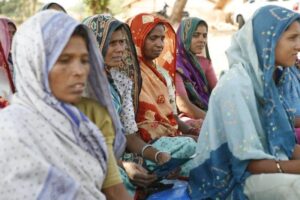India has experienced exponential growth and enacted innovative financial initiatives in recent years, but promising indicators of greater financial inclusion mask a concerning trend. About half of the women in India with personal bank accounts use them in a limited capacity or not at all. Women’s World Banking’s India Strategy addresses why women aren’t engaging with financial services, lays out a plan to better understand the trend, and outlines a systemic remedy that will result in greater financial opportunity.
India’s Story of Growth

These efforts, though not without flaws, have significantly increased access to and inclusion in India’s economic system. In 2011, only 53 percent of adults in India had a bank account. In 2017, that number reached 80 percent with a gender gap of just 6 percent, a significant improvement from 2014, when the gender gap was 14 percent.
The numbers indicate a positive trajectory for one of the world’s strongest emerging markets, but they don’t tell the entire story. Despite the narrowing gender gap, women—especially underserved or low-income women—still lag behind men in critical ways.
Where Women Fall Behind: Engagement
While the lines on India’s various economic charts trend upwards, dangerous gender disparities persist. For example, only 51 percent of women are literate, compared to 77 percent of men. Women also face greater health risks, like a high maternal mortality rate, and are increasingly less likely to participate in the workforce. So, while data suggest improvement in women’s financial access and inclusion, it’s important to look more closely at how and exactly to what extent women really participate in India’s economy. Consider this: of that 77 percent of Indian women with a bank account, about 50 percent use it either in a limited manner or don’t use it at all. This statistic illustrates a larger problem, but it also provides a starting place to solve it.
While India’s FinTech sector accelerates, its asset-management industry grows, and its government fosters financial innovation, women remain largely outside of the financial fold, underserved and unengaged. The problem is that they aren’t taking advantage of the gateway to financial inclusion: basic banking services, such as savings. This stymies economic growth, hinders social progress, and represents an enormous opportunity missed.
Making it possible for more women to engage with their savings accounts will allow them to increase their financial capital, their financial understanding, and ultimately, their financial inclusion. Women, in turn, will use a greater number of financial services and invest back into the economy. There are approximately 430 MM women in India, which means well-executed, products and programs designed with women’s needs in mind represent an enormous opportunity to scale up. Because India’s population skews young, there is also huge potential for long-term customers for financial service providers.
Women’s World Banking’s Country Strategy
The barriers preventing more complete financial engagement among women in India exist both for women and for the financial service providers. Women’s World Banking will implement a strategy that tackles the constraints on both levels.
To begin with, Women’s World Banking will work to better understand Indian women’s specific needs and where the interaction with financial institutions fails. Based on initial research, women’s reasons for remaining “underbanked,” or relying on alternatives to their bank accounts, include issues like not owning a mobile device, a tradition of cash transactions, limited understanding of the value in banking, and lack of financial literacy.
Better understanding the nuances of women’s barriers to financial inclusion will give way to stronger initiatives. Microinsurance, digital financial services, and the use of third-party business correspondents (who bring financial services right to women’s doorsteps) already stand out as promising areas of opportunity in which to act.
Women’s World Banking will partner directly with financial service providers—e.g. small finance banks, commercial banks, and insurance companies—to design women-centered products, teach risk-mitigating strategies, and encourage asset building. Take Small Finance Banks as an example: many of them were once microfinance institutions and therefore know the underserved women’s market already. Those relationships, combined with Women’s World Banking’s significant experience in education and training, will ensure a productive and sustainable partnership. A Small Finance Bank whose employees learn to introduce new products to clients who already trust them will see greater engagement more quickly.
How to Reach and Recognize Success:
Women’s World Banking is setting out to be the preeminent advocate for women’s financial inclusion in India. To do that, it will partner with local financial service providers and facilitate an ongoing dialogue via media coverage, conferences, and education efforts.
Measurable indicators of the strategy’s success include:
- Implementation of women-focused financial programs by India’s government
- An increased number of banks and other financial service providers that develop strategies to target underserved women
- A rise in the average savings account balance
- A greater percentage of women saving consistently to reach a goal
- More women having both active savings accounts and buying health insurance voluntarily
- A greater percentage of women who are able to complete transactions through digital technology
The return on investment—of time, resources, and attention—is enormous. Once women experience greater financial agency, their participation will help power the engine of sustained economic growth in India.



